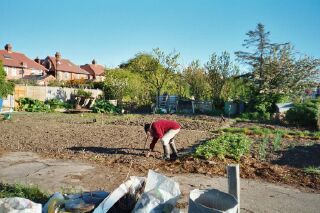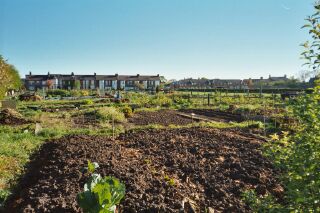Archery | Boldon Community Association | Boldon villa Football | Boldon Parks | Fishing | Gardening | Victoria Allotments Association | Art Group | Golf | History Society | East Boldon Library | Mid Boldon Club | Open Garden | Local Walks | Boldon Festival | Socatots | Pitch in for Kids | Belly Dancing
Leisure Activites in Boldon
The Victoria Allotments Association

Looking North West

Looking North
Victoria Allotments Association
The earliest records of the Association are dated May 1922 but it would seem from the correspondence that it had been going for some time before that. The land was rented from the Harton Coal Board for the princely sum of £18 per annum. It is interesting to note that at that time the Telephone number of the Trustee was Boldon 8. I wonder how many telephones there were in Boldon then.
In this year's newsletter to the members of the Association the Chairman, Don Graham, gave the following brief history.
The Association was founded during the first World War, when food was scarce and everyone was much more self-reliant. At that time the allotments were much more extensive, covering more than double the area they now occupy. The field to the east of the present cultivated area was all divided up into allotments, which continued right down to Victoria Terrace, where there was a long stone wall enclosing the allotment area and the adjoining field, with an arched gateway for members. This wall has been replaced by a wooden dence but a remnant of the old encloseure still stands today. It has become the garden wall of no. 14, South Lane. Before this house was built, this remnant was the beginning of the orginal enclosure, which stretched form this point parallel to the houses of Victoria Terrace, which was much narrower in those days, right along to the junction with Bridle path. Down the middle of the allotments,running north and south, where there is now a barbed wire fence, there was a wide pathway, along which a horse and cart could be lid to deliver manure.
This arrangement continued until the early 50's, when the membership began to decline, largely due to cheaper vegetables appearing in the shops. At this time, because some of the allotments were beginning to be neglected, the church Commissioners, owners of the land, took over half of the area, that part which is now Mr. Colley's field, and leased it to Mr Gibson senior who was very glad to get it, because up till that time, he had had to lead his cows up Bridle Path, to the annoyance of some of the residents. The long stone wall had already disappeared by this time, demolished by the Local authority in order to widen Victoria Terrace for motor traffic, and the allotment area assumed more or less its present aspect. With one exception however, All the allotments at that time covered the whole width of the area, whereas overs recents years they have been divided into two as they became vacant.
We have 35 members working the allotments lying to the east of Bridle Path in East Boldon where there are 18 plots but most are divided into two and worked as separate gardens.
At present we do not have a vacant plot but if you would like to join the waiting list you could either telephone the secretary (5362258)
This is what I try to do in my allotment, in which I grow vegetables.
January
- Start chitting extra early potatoes
- Start forcing rhubarb.
- Cut out dead wood from apples and pears
February
- Clean out the water but.
- Buy seed potatoes
- Cut out the old stems from the blackcurrent bushes and remove any branches that might lean over too far when they are loaded with fruit.
- Sow some of the parsnip seeds and keep some to put in next month.
March
- Prepare soil for early sowings and cover with cloche to warm up the soil.
- Sow leek, cabbage, kale and calabrese in trays in the garden shed.
- Sow beetroot, broad beans and kohl rabi outside.
- Cover some of the rhubarb with a wooden box to force it for early picking.
- Sow a few parsley seeds to maintain a progression.
- Set out early potatoes in light position to encourage shooting.
- Plant shallots.
April
- Sow carrots and swedes.
- Sow sweetcorn, courgettes and pumkin seeds in pots inside.
May
- Plant the maincrop potatoes, this year for the first time I shall use amour let's hope that they will do as well as its reputation. Cover earlies with fleece if frost is forecast.
- Sow my mange tout peas, carrots, lettuce, beetroot, scallions, radish, parsley and kohl rabi.
- Weed out the onion bed.
- The calabrese I sowed during March and planted out in April has been eaten by the slugs or pigeons so I shall try some fewah seed outside.
- Sow runner beans in pots in the shed.
- At the end of the month put some runner beans in moist peat in a bowl to start them off for plants outside in a couple of weeks.
- Put some straw around the base of the strawberries.
June
- Sow pac choi seeds.
- Protect currants and strawberries against birds and remove any mouldy leaves or fruit.
- Start harvesting early potatoes.
- Proctect young brassicas from pigeons. I use old CD's.
July
- Sow winter radish and turnip.
- Bend the leaves of cauliflowers over the curds to protect from the sun.
- Sow seeds of chinese cabbage.
- Harvest onions
- Prune spend rasberry canes down to ground level.
August
- Peg down strawberry runners into the soil to root.
- Ensure the beans, corgettes and marows do not dry out.
- Prune out fruited raspberry canes and tie in new shoots.
- Continue sowings of kohl rabi, beetroot and lettuce as well as French beans and runner beans.
- Sow spring cabbage.
September
- Plant out Autumn onion sets (Swift) to harvest in May
October
- I don't seem do do much in October apart from digging over and keeping down the weeds.
November
- Prune currents and gooseberries.
Gooseberry Bush
- Leave a leg of about 6 inches
- Cut back all but 8 well spaced branches.
- In early Spring cut back new growth by half to an upward facing bud.
- Remove dead wood, centre shoots, and any low branches which will be weighed down with a crop.
- In mid July cut side shoots to 5 leaves.
Links to other leisure activities:
Archery | Boldon Community Association | Boldon villa Football | Boldon Parks | Fishing | Gardening | Victoria Allotments Association | Art Group | Golf | History Society | East Boldon Library | Mid Boldon Club | Open Garden | Local Walks | Boldon Festival | Socatots | Pitch in for Kids | Belly Dancing
Archery | Boldon Community Association | Boldon villa Football | Boldon Parks | Fishing | Gardening | Victoria Allotments Association | Art Group | Golf | History Society | East Boldon Library | Mid Boldon Club | Open Garden | Local Walks | Boldon Festival | Socatots | Pitch in for Kids | Belly Dancing
- Home
- Messages
- Leisure Activities in Boldon
- Churches
- The History of Boldon
- Grade II listed buildings in Boldon
- Boldons History Society
- Boldon Festival
- Local Buildings
- St George's Church
- The Village Hall
- Nearby Attractions
- Pubs Clubs and Restaurants
- Local Characters
- East Boldon Library
- Victoria Allotments
- Links
- Little Acorns
- Local Project
- Music
- Reminiscences
- Photos
- Environmental Education Centre
- The Boldon Buke
- contributors
- Meetings
- Socatots
- Boldon Walks
- Open Garden
- Boldon House
- Cannon Eric Stephenson
- Etta's Seat
- Scots House
- Kay Taylor
- Belly Dancing
- Rembrance Day
- Horses
- Taekwon Do
- School
- Boldon Carnival
- Trial
- Boldon Lodge
- 100 Front Street
- South Lodge
- Laverick Hall
- Boldon Mill
- Doorway to Rectory Green
- Downhill House
- Mansion House
- 36 Front Street
- 64 Front Street
- 94 Front Street
- Cottages
- Downhill Farmhouse
- Limekiln
- Boldon House 2
- St Nicholas Church Hedworth Lane
- west-boldon-hall
- Fellgate Farmhouse
- Scots House 2
- St Nicholas Church Boldon
- Hylton Grove Bridge
- Where we are
- Ebenezer Church